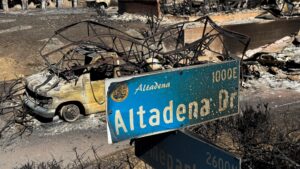Wildfire Catastrophe in Los Angeles: Implications for Investors in the Insurance Sector
As the specter of wildfires looms over Los Angeles, the financial ramifications for the insurance sector are becoming increasingly stark. With active fires burning vast areas, including densely populated neighborhoods, analysts are adjusting their predictions for insured losses—estimates are now pegged at a staggering $30 billion. This figure extrapolates the financial fallout beyond the previously record-setting Camp Fire in 2018, which resulted in $12.5 billion in damages. If you’re an investor or thinking of entering the insurance market, understanding the potential impact on high net worth insurance providers can be crucial for your investment strategy.
Insurance Industry Faces Major Challenges
According to insights from industry giants like Goldman Sachs and Wells Fargo, the fallout for insurers could be substantial, with certain companies potentially facing earnings hits approaching 20%. Bank of America emphasizes that the devastation is particularly pronounced in areas, such as Pacific Palisades, characterized by high property values and a clientele focused on high-net-worth policies.
The Palisades Fire, alone, has consumed over 17,000 acres and demolished more than 1,000 structures, leaving behind monumental insurance claims. Notably, the average home price in Pacific Palisades stands at a staggering $3.5 million, amplifying both the extent of loss and the potential liability for insurers.
High-Net-Worth Insurers Feeling the Heat
Specialized insurance providers catering to high-net-worth clients, like Chubb and Cincinnati Financial, are poised to absorb a larger share of these losses. Bank of America’s analysis predicts a potential 20% drop in earnings per share for Cincinnati Financial in 2025 due to these catastrophic losses. Similarly, Chubb and Everest could face double-digit declines in EPS.
For investors, this presents both caution and opportunity. Stocks for Chubb and Cincinnati have already seen declines of approximately 5.1% and 4.6% respectively over the past week, indicating immediate market volatility. These fluctuations may present a buying opportunity for savvy investors who can also foresee a potential recovery once the wildfire threats diminish.
Broader Market Implications
In contrast, the middle-market insurers—and companies like Progressive—are expected to be less exposed to these high-stakes losses. Understanding the dynamics not just at the company level but within the broader insurance landscape is essential for investors. The potential long-term market shifts stemming from increased wildfire incidences could impact premiums, policy structures, and even consumer behaviors in the real estate market.
As Oppenheimer pointed out, a specific subset of public carriers in California holds a remarkable 20% combined market share in the homeowners market. Among these, Mercury General appears particularly vulnerable, having faced a 22% drop in share value this month and commanding a market share of 6.5%.
The Takeaway: Smart Investing Strategies
In navigating these turbulent times, investors would do well to reflect on several key points:
-
Monitor Market Adjustments: Keep an eye on the changes in share prices for companies exposed to high-net-worth sectors while considering overall insurance industry trends.
-
Evaluate Exposure Levels: Analyze the risk exposure of your portfolio to companies in areas affected by natural disasters, as their financial health could be directly affected by state and local regulations aimed at combating fire risks in high-value areas.
-
Diversify Wisely: While some insurers may be suffering significant losses, others could emerge resilient. A well-diversified portfolio can hedge against dramatic shifts within specific sectors.
- Stay Updated on Policy Changes: Legislative responses and shifts in building codes related to wildfire management could impact future risk assessments and should be integrated into any investment thesis.
By leveraging these insights from our team here at Extreme Investor Network, you’ll be better equipped to make informed decisions in a rapidly evolving investment landscape. The interplay of natural disasters and financial markets is complex, but understanding these nuances can help you navigate your investment strategy wisely—even amid uncertainty.

